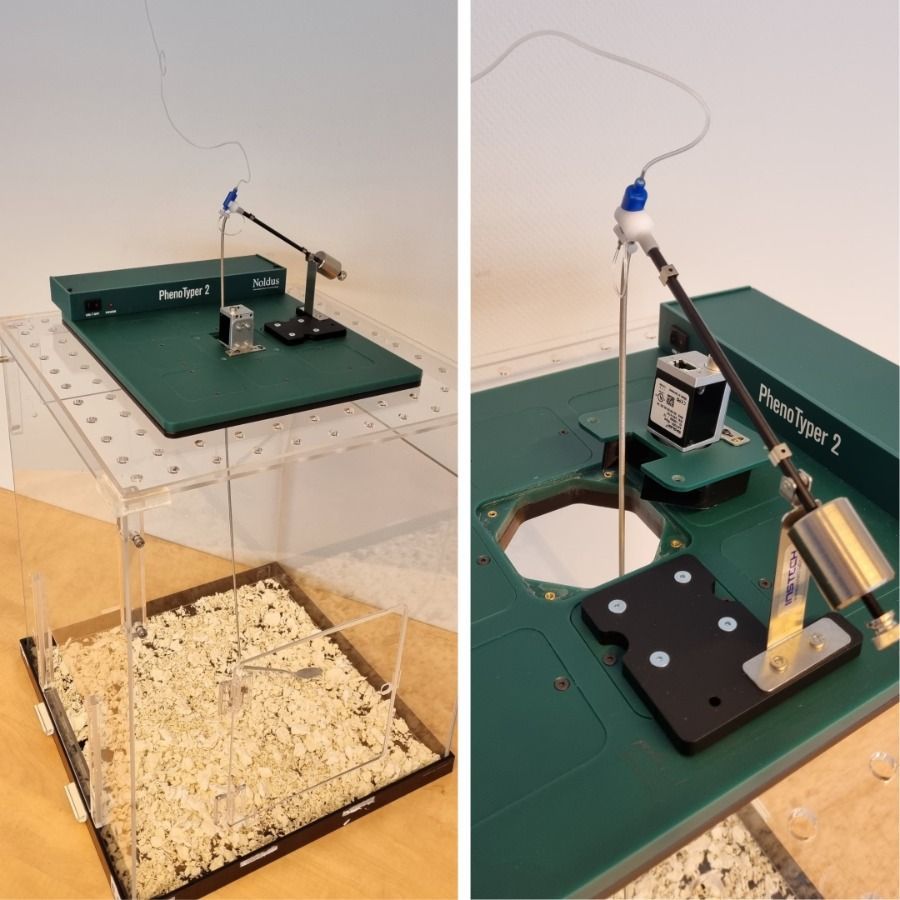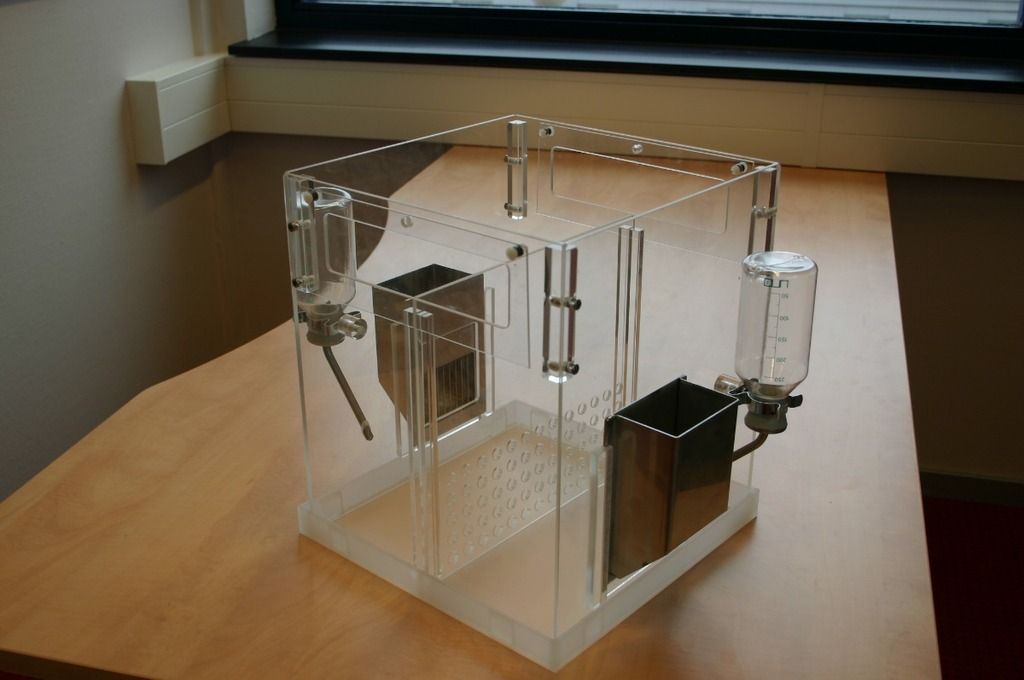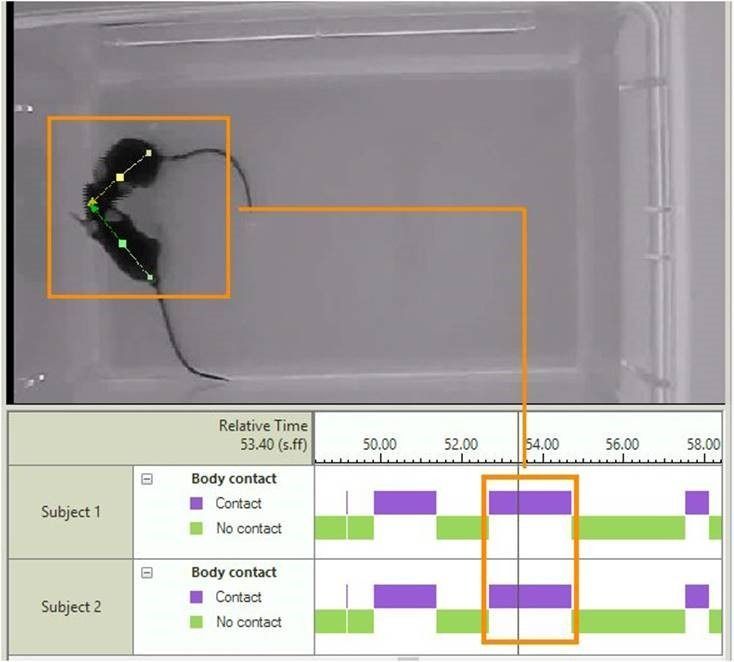Did you know you can (semi) socially house tethered animals?
Socially housing tethered animals can be challenging, but also crucially beneficial to your study. Read more about how with our PhenoTyper we can solve that dilemma!
Posted by
Published on
Thu 02 May. 2024
Topics
| EEG | Mice | PhenoTyper | Physiology | Rats | Social Interaction |

A significant challenge in behavioral neuroscience research is maintaining social housing for tethered animals. Tethering, which involves attaching devices like EEG electrodes or infusion cannulas to animals, is crucial for continuous physiological monitoring and substance delivery. However, such a setup does not only restrict an animal’s movement, but also prevents social housing, which can be vital for the well-being and natural behavior of rodents.
Pros and cons of social housing in rodents
Pros- Behavioral enrichment: Social interactions facilitate the development of natural behaviors such as grooming, playing, and social hierarchies. These interactions are essential for cognitive and emotional development, contributing significantly to the physiological health of rodents.
- Stress reduction: Rodents housed in groups typically exhibit lower stress levels. This reduction in stress can decrease the occurrence of stress-induced pathologies, enhancing the general health and well-being of the animals.
- Reliable research outcomes: Studies conducted in socially housed environments often yield more reliable and generalizable results, as the behaviors observed are (more) representative of a natural setting.
Cons- Aggression and competition: Social housing can lead to aggression and competition among rodents, potentially resulting in injuries and skewed experimental data.
- Increased stress: Because of the above-mentioned, social housing can actually also increase (social) stress. Especially in larger groups that deal with strong hierarchal structures within the cage.
Why Tethering?
- Continuous monitoring: Tethering allows for the uninterrupted collection of physiological data, crucial in studies requiring detailed, real-time monitoring such as sleep cycles, seizure activities, or drug effects.
- Precise substance delivery: Infusion cannulas can deliver drugs or other substances directly into specific regions of the brain, providing targeted therapy and precise dosing controls essential for pharmacological studies.
- Aggression and competition: Social housing can lead to aggression and competition among rodents, potentially resulting in injuries and skewed experimental data.
- Increased stress: Because of the above-mentioned, social housing can actually also increase (social) stress. Especially in larger groups that deal with strong hierarchal structures within the cage.
Why Tethering?
- Continuous monitoring: Tethering allows for the uninterrupted collection of physiological data, crucial in studies requiring detailed, real-time monitoring such as sleep cycles, seizure activities, or drug effects.
- Precise substance delivery: Infusion cannulas can deliver drugs or other substances directly into specific regions of the brain, providing targeted therapy and precise dosing controls essential for pharmacological studies.
Tethering typically involves securing the animal to a flexible yet restrictive system that permits some movement while ensuring the stability and integrity of the monitoring devices. And while tethering can limit natural behaviors, the use of lightweight cables, swivels to prevent tangling, and customized cage setups can help minimize stress and discomfort.
Combining tethering with social housing
So, in studies where continuous monitoring is essential, for example in those involving electroencephalography (EEG) to assess neural activity during sleep or response to stimuli, or when conducting a study with continuous drug delivery (by using Instechs swivel arm in the PhenoTyper 2, see image below). In these cases retaining an animal's social environment would be beneficial, but unfortunately very challenging until now.

Noldus’ PhenoTyper 2 with perforated wall dividers, offers an innovative and interesting compromise. By partitioning the cage into separate yet accessible sections, you can maintain sensory interactions among the animals. This setup not only retains the essential social context, but also accommodates the logistical demands of tethering, striking a balance between animal welfare and research integrity. In the PhenoTyper 4500 (version used for rats) you can even divide the arena into 4 areas.
This wall divider allows researchers to divide the enclosure into two or more distinct compartments, and incorporates a semi-social housing condition. This can thus strike a balance between the well-being and natural behavior of rodents, while the PhenoTyper 2 topunit accommodates the necessary equipment for tethered neurological monitoring and other interventions. The subject can be connected to monitoring equipment via a tether, while it can still interact with a partner.
The wall divider can for example be outfitted with holes that are sized and positioned in such a way to allow the rodents (mice) to interact and communicate with their cage mates, thereby retaining a level of social interaction. This mitigates both the (social) stress associated with complete social isolation, and any severe aggression issues as well.

A PhenoTyper cage with the perforated wall divider
Also beneficial with the use of wireless headstages
Wireless headstages, a useful tool for monitoring neural activity without the restriction of cables, can also prove to be difficult to use in social housing settings: The headstages can be prone to dislodgment due to fighting or gnawing, common behaviors when animals are housed together. The implementation of wall dividers in the Noldus PhenoTyper can help mitigate these risks. These dividers will thus still allow for social interactions through sensory contacts without full physical contact, reducing the likelihood of aggressive interactions that can lead to the displacement or damage of the wireless headstages. Protecting the integrity of the data and valuable equipment while also maintaining a higher level of animal welfare.
Customizable and easy to integrate
The wall divider is easy to install and can be customized to meet specific experimental requirements. This flexibility makes the PhenoTyper, in general, an invaluable tool for researchers who require adaptable solutions for complex behavioral studies. The system is powered by Noldus’ EthoVision XT software to further ensure that data collection and analysis are seamless and precise, providing researchers with high-quality, reliable data for in-depth behavioral analysis. The PhenoTyper is thus the ideal choice, and sustainable (future-proof) solution, for researchers aiming to conduct cutting-edge studies in neuroscience and related fields.

Real world use
Here are two real-world examples where the PhenoTyper has been used in studies that could benefit from this wall divider functionality:
- Researchers from Baylor College of Medicine used the PhenoTyper system to study the Stargazer mouse model for epilepsy. These mice, which have a genetic mutation affecting their balance and causing spike-wave seizures, were observed in a home cage environment to monitor their behavior and response to environmental changes over time. This kind of study could benefit from the use of the wall divider to house mice socially and separate them, In this way, studying social and environmental impacts on neurological conditions becomes a realistic research goal. Find the blog and the study here!
- Buschoff et al did a study with Noldus’ PhenoTyper, in which they effectively managed the tethering of rats while allowing considerable freedom of movement, which is essential for normal behavior during EEG monitoring. Their PhenoTyper was equipped with an electrical swivel with a counterbalanced arm, enabled rats to move freely and lift their head while still being connected to EEG recording equipment. This setup facilitated the continuous monitoring of electrical activity in the rats' brains, specifically looking at spike wave discharges, which are crucial for studies involving epilepsy. Adding a social component to this study could be interesting. Find the blog and the study here!
- Although the study by Bin et al does not use Noldus’ PhenoTyper, it does describe the modifications to a standard mouse cage, which was divided into compartments to facilitate both housing and recording needs. In this case the use of a low torque slip ring as an EEG commutator for continuous tethered EEG monitoring of mice. The setup and/or customization for this study could have been a much more out-of-the-box solution with the PhenoTyper and its wall divider.
All in all, the PhenoTyper is a very powerful and versatile piece of tech. You can read about all of the many uses of the PhenoTyper here. Interested to use it to advance your research? Then make sure to also check out the resources below.
And of course, always feel free to reach out if you have any comments or questions!
Related Posts

Classical music affects affiliative behaviors in bottlenose dolphins

The social interaction test: effortless and dependable with EthoVision XT

